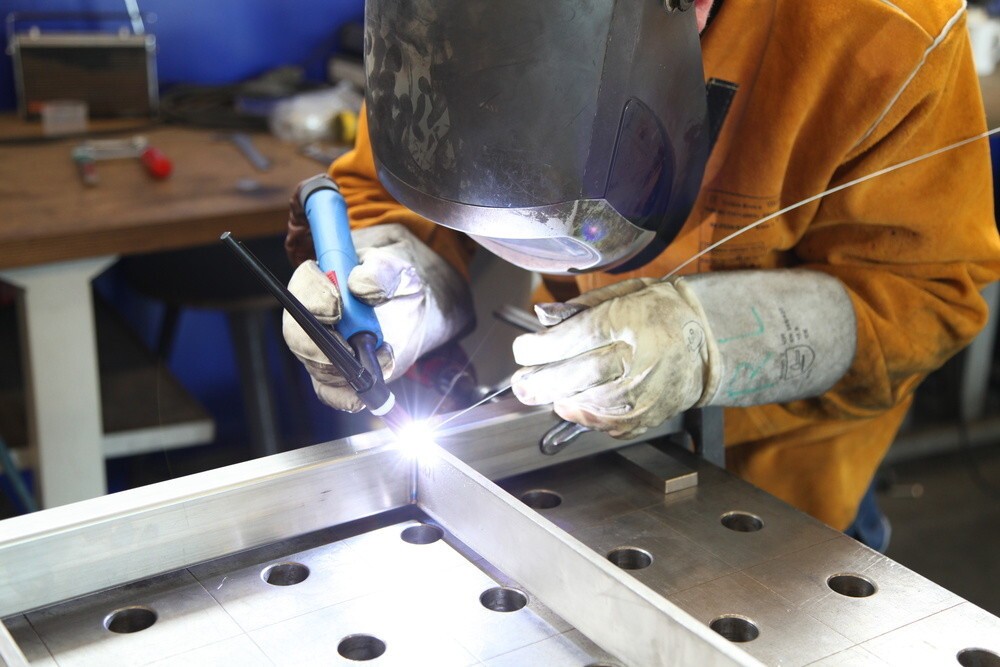Stainless Steel is one of the most useful items for production and manufacturing, especially for the fabrication industry. Due to its versatile properties, you will see stainless steel being used everywhere around you.
From culinary uses to aerospace applications and for surgical equipment and tools, stainless steel is all around you. Stainless steel is the most environmentally friendly and recyclable material making it perfect for use in different applications.
In short, we can say that stainless steel is the most used material all around the world, and due to its features and qualities, the use of it is increasing exponentially.
Why Weld?
Welding is used for linking two or more than two elements or metals together. There are different methods and techniques available for weldings, such as Gas Metal Arc Welding also known as MIG welding, Shielded Metal Arc Welding, etc.
For welding a product, you need to have sufficient knowledge of it; otherwise, you may end up damaging the material.
- Stick Welding
If you are going to weld stainless steel, Stick Welding is the preferred method. This technique is easy to learn, so even if you are a beginner, you can weld stainless steel without facing any difficulty.
Welding stainless steel is not different from welding other types of materials, but it requires more attention to details, and you need to check the filler metals with the welding material, whether they are matched or not.
Stick welding uses consumable electrodes to weld the objects. The electric arc is formed between the joining metal and the electrode using the AC or DC current as the power source.
The consumable electrode is then melted that is placed to form a joint. The electrodes are coated with a metal flux, which enhances the value and solidity.

Set Up, Preparations and Process
- Safety
Welding involves severe risk as you are going to work with electricity and intense heat. Consequently you need to be very cautious while carrying out the process. If you did not follow the safety guidelines, you might damage yourself physically.
For your safety, you need to follow a set of instructions. Firstly, you need to make sure that you are performing the operation in an open space, which means that you are sitting comfortably and can move easily.
Second, you must wear safety goggles and a welding helmet in order to protect your eyes and head, check that you are getting a clear view of the material. Leather gloves and a jacket are also needed to protect the body fully. You also need to wear the welding mask if the welding process produces any harmful gases.
- Setting Up Equipment
For performing the welding process effectively and smoothly, you should always proceed step by step. After getting hold of the personal protective equipment, you need to set up the materials which need to be weld and the welding equipment.
For stick welding, you need a constant current power supply, consumable electrodes, ground clamps, electrode holder, and welding cables.
Choose a suitable time, and it is important to make sure that the power supply is not interrupted during the welding process.
When it comes to choosing the consumable electrodes, you can select them based on the type of material that needs to be weld.
- Starting the Welding Process
Once you have set up the tools and equipment and wearing personal protective equipment, you are set to start the welding process. It is always a good idea to clean the stainless steel properly as it helps in quality welding.
Stick welding is a manual process; therefore, you need full concentration on the job to perfectly weld the stainless steel. A minor mistake can cause severe damage and will make the procedure much more challenging and difficult.
Don’t forget to check the temperature of the base material and the welding metal because exceeding the limit will directly affect the welding product.
You can check the temperature by any method you like by infrared electronic thermometers or by Temperature-indicating sticks.
Now comes the time to weld the material. For perfection and quality, it will be beneficial for you if you know about the type of stainless steel you are going to weld because, for different types of stainless steel, different techniques are used. Below we will express the detailed process for three key categories of stainless steel.
- Austenitic Stainless Steel
It is the most common type of stainless steel; it normally has very high corrosion resistance and is known for durability and strength. Austenitic Stainless Steel is mostly used for culinary items and other related products.
For welding Austenitic Stainless Steel you need to move slow and steady. This type of stainless steel does not require preheating the metal, and you need to stop welding once it reaches to a certain limit.
If you move fast or at a high temperature, the welding product can get cracked. Make sure that the metal filler is properly filled around the place.
- Martensitic Stainless Steel
Martensitic Stainless Steel is mainly used for wear-resistant material and projects. This type of steels are magnetic, and due to their properties, these are mostly used for surgical equipment and other such applications which requires hardness.
When welding the Martensitic Stainless Steel, you need to preheat the material around 400 to 600 degrees F, and during the process, the temperature should not go down below the preheat temperature. Maintaining an appropriate temperature is very important when welding this form of stainless steel.
- Ferritic Stainless Steel
You can find Ferritic Stainless Steel in automotive products and applications. This type of stainless steel is also magnetic and has enhanced thermal conductivity.
For welding the ferritic Stainless Steel, you need to go with low heat temperature. For this type of stainless steel, it is preferable that you use the same type of metal filler as the base material.
The last step for welding is that you let it cool down and then remove the slag appropriately. Check for the joining parts if there is any spot left without the filler.
Common Characteristics
No matter the type of stainless steel you are going to weld, there are some common elements that you need to be careful about. First of all, make sure that the welding is properly cleaned and the current power supply is constant.
The other important thing to monitor is the temperature; if you can control it, you will weld the product clean and perfect.
Lastly, use the appropriate metal filler for specific stainless steel. If you follow the steps and guidelines as it should be, you will get the perfect welded product at the end.
